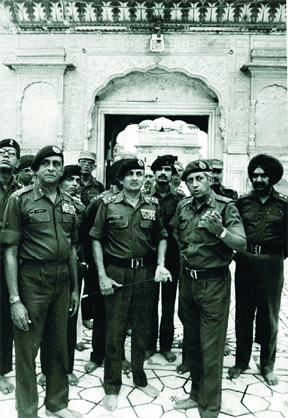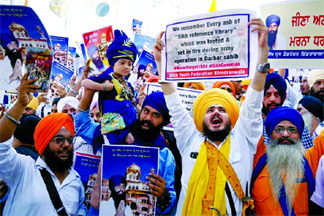Operation Bluestar, executed by the Indian Army in June 1984 at the Golden Temple in Amritsar, was not merely a military offensive—it became a watershed moment in the history of Sikhism. For the Sikh community, it was not a battle against terrorism but an unforgivable desecration of their holiest shrine, an assault on their collective identity, and the beginning of a long era of emotional, political, and spiritual rupture.In Sikh history, the term Ghallughara, meaning “holocaust” or “massacre,” has been used to describe periods of mass violence inflicted upon the Sikh people. Operation Bluestar is remembered as the Teeja Ghallughara (Third Holocaust)—a modern-day catastrophe that left a deep scar on the Sikh psyche.
Historical Context: Sikh Ghallugharas
The Sikh community has endured repeated episodes of persecution and massacres known as Ghallugharas:
– Chhota Ghallughara (1746): A brutal massacre by Mughal forces in which thousands of Sikhs were killed.
– Wadda Ghallughara (1762): The Great Massacre where Afghan invader Ahmad Shah Abdali killed tens of thousands of Sikhs in one day.
– Teeja Ghallughara (1984): The storming of the Golden Temple by the Indian Army, followed by the anti-Sikh riots post-Indira Gandhi’s assassination.
These historical traumas are etched deeply into the Sikh collective consciousness as moments of suffering and sacrifice, but also resilience.
Devastation of the Golden Temple Complex
The Indian Army’s use of tanks, heavy artillery, and infantry inside the sacred Golden Temple complex caused massive physical destruction:
– Damage to the Akal Takht: The Akal Takht, the supreme temporal authority of Sikhism, was heavily damaged. It was reduced to rubble, which was an unimaginable blow to Sikh spiritual sovereignty.
– Destruction of the Sikh Reference Library: The library housed centuries-old scriptures, historical documents, handwritten manuscripts, and relics of the Gurus. Its burning was perceived as a deliberate attempt to erase Sikh history.
– Widespread Casualties: Estimates of deaths vary, but it is widely accepted that hundreds, possibly thousands, of militants, civilians, and pilgrims died during the assault. The presence of unarmed pilgrims and non-combatants inside the complex intensified the trauma.
Desecration and Violation
The Golden Temple is not only a place of worship but a sanctuary, a symbol of Sikh identity and spiritual refuge. The operation violated this sanctity, leaving many Sikhs feeling profoundly betrayed and humiliated. The act of soldiers entering the shrine with weapons and destroying sacred sites was seen as sacrilege.
Impact on the Sikh Psyche
Collective Trauma and Spiritual Wound: Operation Bluestar was not experienced as a simple military action but as an assault on Sikh identity and spirituality.
– The sense of violation was akin to a profound spiritual wound. The Guru Granth Sahib, the eternal Sikh scripture, and the sanctity of the Harmandir Sahib were perceived to be attacked.
– Many Sikhs described feelings of shock, disbelief, and grief, similar to collective mourning for a devastating loss.
– This trauma entered the cultural memory as a form of existential crisis, shaking the foundations of Sikh confidence in the Indian nation-state.
A Crisis of Faith and Identity
For many, Bluestar triggered a deep crisis of faith – not in Sikhism itself, but in the protection that the Indian state was supposed to offer its minorities. The event forced Sikhs to re-examine their place in India.
– Feelings of alienation and vulnerability intensified.
– The Sikh community felt targeted, marginalized, and feared further erosion of their political and cultural rights.
– Many Sikh youth turned towards assertive identities, including militancy, as a way of reclaiming dignity and protecting their heritage.
The Aftermath
The trauma of Bluestar was compounded by the horrific anti-Sikh riots that erupted in November 1984, after the assassination of Prime Minister Indira Gandhi by her Sikh bodyguards.
– Over 3,000 Sikhs were massacred in Delhi alone, with thousands more killed in other parts of India.
– The widespread nature of the violence, often with alleged complicity or passive support of political actors, deepened feelings of betrayal.
– This event reinforced the perception of systemic persecution, making the Sikh community feel under siege.
The combined effect of Operation Bluestar and the 1984 pogroms is often described as a modern Ghallughara, reshaping Sikh political and social consciousness.
Sociopolitical and Cultural Ramifications
Rise in Sikh Militancy and Calls for Khalistan
– Operation Bluestar galvanized militant groups advocating for a separate Sikh homeland, Khalistan.
– The event became a rallying cry for those who saw armed struggle as the only means to protect Sikh interests.
– While the majority of Sikhs did not support violence, the trauma legitimized radical political voices in many communities.
Diaspora Mobilization
– Sikh diaspora communities in Canada, the UK, and the US responded with protests, fundraisers, and political lobbying.
– Bluestar strengthened Sikh identity abroad and heightened advocacy for human rights and justice.
– The diaspora became crucial in keeping the memory alive and pushing for international awareness.
Memory, Mourning, and
Identity Preservation
Commemoration as a Collective Process
– Every year, Sikhs commemorate the anniversary of Operation Bluestar with memorial prayers (Ardas), candlelight vigils, and seminars.
– The event is remembered in literature, music, and art, serving both as a mourning and a form of resistance.
Passing Trauma Across Generations
– The trauma has been passed down through oral histories, storytelling, and family narratives.
– New generations understand Bluestar as part of their identity, often with strong feelings of justice, remembrance, and resilience.
Psychological Effects: Trauma and Healing
– Many Sikhs suffered from post-traumatic stress, depression, and a sense of helplessness.
– Counseling and support structures were limited, especially in the 1980s and 1990s.
– Over time, Sikh organizations and mental health professionals have worked to address this trauma through community healing initiatives.
An Unhealed Wound
Operation Bluestar was more than a military event-it was a collective trauma that profoundly altered Sikh consciousness. It was a moment when the sanctity of faith, the integrity of identity, and the sense of security for millions of Sikhs were violently shattered.The memory of the Teeja Ghallughara continues to influence Sikh politics, culture, and spiritual life. Until the wounds of 1984 are acknowledged and healed with justice and reconciliation, the pain and mistrust remain a defining feature of Sikh relations with the Indian state.
Operation Bluestar and its deep impact on the Sikh psyche: The third ghallughara
